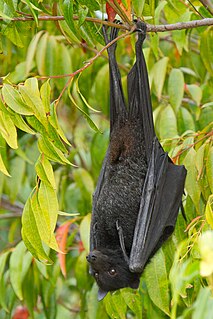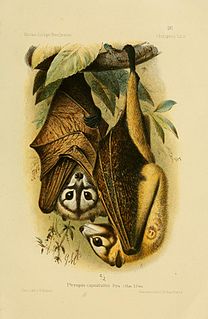
Megabats constitute the family Pteropodidae of the order Chiroptera (bats). They are also called fruit bats, Old World fruit bats, or—especially the genera Acerodon and Pteropus—flying foxes. They are the only member of the superfamily Pteropodoidea, which is one of two superfamilies in the suborder Yinpterochiroptera. Internal divisions of Pteropodidae have varied since subfamilies were first proposed in 1917. From three subfamilies in the 1917 classification, six are now recognized, along with various tribes. As of 2018, 197 species of megabat had been described.

The little red flying-fox is a megachiropteran bat native to northern and eastern Australia. The species weighs about half a kilogram, one US pound, and is the smallest species of Pteropus in mainland Australia. P. scapulatus occurs at the coast and further inland, camping and flying to the tropical to temperate regions that provide them with an annual source of nectar. They exhibit an unusual method of obtaining drinking water during dry periods, skimming a stream's surface to gather it onto their fur while they are in flight.

The black flying fox or black fruit bat is a bat in the family Pteropodidae. It is among the largest bats in the world, but is considerably smaller than the largest species in its genus, Pteropus. The black flying fox is native to Australia, Papua New Guinea, and Indonesia. It is not a threatened species.

The Aldabra flying fox is a species of megabat in the genus Pteropus. It is endemic to the Aldabra Atoll in the Seychelles, like Chaerephon pusilla, though the latter may be the same species as the little free-tailed bat.

The silvery flying fox, also known as Ambon flying fox, or silvery fruit bat, is a megabat in the genus Pteropus from eastern Indonesia. It is known from a single, damaged, and immature specimen that was thought to have been from Ambon, but may in fact have been collected on Gebe Island. Although often included in Pteropus chrysoproctus, it was reinstated as a separate species in 2008.

The Moluccan flying fox, also known as the Ambon flying fox, is a species of megabat in the genus Pteropus.

The Indian flying fox, also known as the greater Indian fruit bat, is a species of flying fox native to the Indian subcontinent. It is one of the largest bats in the world. It is of interest as a disease vector, as it is capable of transmitting several viruses to humans. It is nocturnal and feeds mainly on ripe fruits, such as mangoes and bananas, and nectar. This species is often regarded as vermin due to its destructive tendencies towards fruit farms, but the benefits of its pollination and seed propagation often outweigh the impacts of its fruit consumption.

The gray flying fox is a species of flying fox in the family Pteropodidae. It is not to be confused with the grey flying fox. It is found in Indonesia, but not in the Philippines, despite occasional reference to such. Very little is known about this species. The gray flying fox has small size and neutral coloration with a brownish head and an orange abdomen. It probably roosts individually or in small groups. It was listed on appendix II of CITES, and is classified as "Data Deficient" by the IUCN. This species has been decimated by hunting for bushmeat in Indonesia. The hunters use fishing hooks, ropes, and other supplies to hunt the bats. The ropes and hooks are placed along their flight paths, tearing and ensnaring the bats' wings when are flying. In the course of a hunting season, entire colonies can be killed.

The Lombok flying fox is a species of megabat in the genus Pteropus. It is endemic to Indonesia. This species has been listed on Appendix II of CITES since 1990, along with most others in the genus Pteropus. It was classified as "Least Concern" by the IUCN in 1996, but was changed to "Data Deficient" in 2008 due to uncertainty of the abundance and possible threats from hunting and habitat destruction.

The black-bearded flying fox is an endangered species of megabat in the genus Pteropus. It is endemic to Indonesia, found on the islands of Ambon, Buru, Seram, Banda, and Yamdena. Currently considered monotypic, it formerly included the Aru flying fox and Kei flying fox as subspecies.

The black-eared flying fox, species Pteropus melanotus, is a bat of the family Pteropodidae (megabats). Also known as Blyth's flying fox, it is found on the Andaman Islands and Nicobar Islands (India), and in Sumatra (Indonesia). A population on Christmas Island, which is critically endangered, has been placed as a subspecies of this population. The conservation and taxonomic status of that population was later re-established as a distinct species, the Christmas Island fruit-bat Pteropus natalis.

Pteropus pelagicus is a species of fruit bat in the family Pteropodidae. It includes two subspecies that were formerly recognized as full species— Pteropus insularis and Pteropus phaeocephalus. It is endemic to Micronesia. It is threatened by habitat loss.

The insular flying fox or Pacific flying fox is a species of flying fox in the family Pteropodidae. It is geographically widespread, the most widespread flying fox in the Pacific: it is found in American Samoa, the Cook Islands, Fiji, New Caledonia, Niue, Papua New Guinea, Samoa, the Solomon Islands, Tonga, and Vanuatu.

The large flying fox, also known as the greater flying fox, Malayan flying fox, Malaysian flying fox, large fruit bat, kalang, or kalong, is a southeast Asian species of megabat in the family Pteropodidae. Despite its scientific name, it feeds exclusively on fruits, nectar, and flowers, like the other flying foxes of the genus Pteropus. It is noted for being one of the largest bats. As with nearly all other Old World fruit bats, it lacks the ability to echolocate but compensates for it with well-developed eyesight.

The Bismarck masked flying fox is a species of flying fox in the family Pteropodidae found in Papua New Guinea and named after the Bismarck Archipelago. It was once considered a subspecies of Pteropus temminckii before being reassessed in 2001. This species has two subspecies, P. c. capistratus and P. c. ennisae. The IUCN classified it as Near Threatened in 2009, noting that the rate of decline is almost high enough to reclassify the species as Vulnerable.

Andersen's flying fox is a species of flying fox in the family Pteropodidae found in south Burma and west Thailand. Although it is hunted for both food and as a pest, it is not known if this has a significant impact on the species. It has been seen roosting in tall, well-established trees in urban areas and will fly several kilometres to eat wild and cultivated fruits. The species was named after Knud Christian Andersen. It was last recorded in Thailand in 1970 and, presumably, there is still a small viable population in Myanmar.

The Kei flying fox is a species of megabat in the genus Pteropus found in the Kai Islands of Indonesia. It was formerly considered a subspecies of the black-bearded flying fox. Very little is known about the species, its habitat, or threats to it.

The Pelew flying fox is a species of megabat in the genus Pteropus found in the Pelew Islands. A subspecies found on Yap, the Yap flying fox, is considered as a separate species by some authorities. The species is listed as vulnerable by the IUCN due to commercial and small-scale hunting; commercial hunting for the species was banned in 1994, but local exploitation is commonplace. The species is listed on CITES appendix I.

The Rennell flying fox is a species of flying fox found in the Solomon Islands. It is an endangered species risking extinction.

The Kosrae flying fox is a species of megabat in the genus Pteropus found on the island of Kosrae, Micronesia.



















